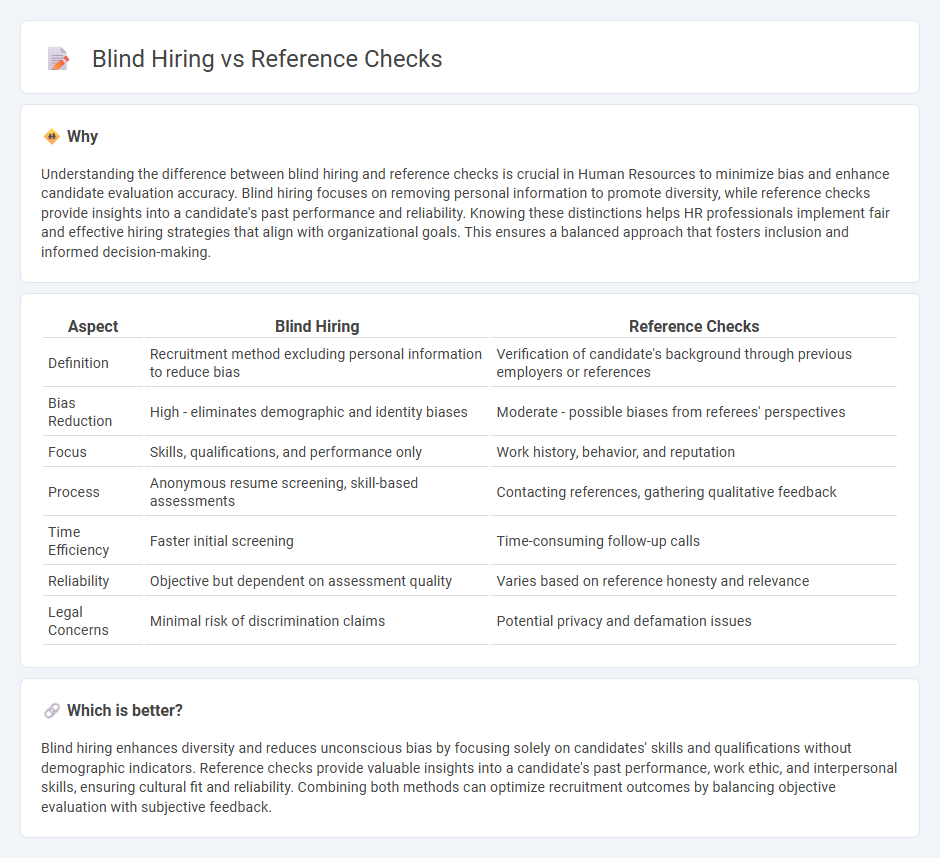
Blind hiring focuses on minimizing unconscious bias by removing identifying information such as names, gender, and education from resumes during the recruitment process, promoting diversity and fairness. Reference checks provide valuable insights into a candidate's past job performance, work ethic, and interpersonal skills by contacting former employers or colleagues. Explore in-depth comparisons to understand how these strategies impact talent acquisition effectiveness.
Why it is important
Understanding the difference between blind hiring and reference checks is crucial in Human Resources to minimize bias and enhance candidate evaluation accuracy. Blind hiring focuses on removing personal information to promote diversity, while reference checks provide insights into a candidate's past performance and reliability. Knowing these distinctions helps HR professionals implement fair and effective hiring strategies that align with organizational goals. This ensures a balanced approach that fosters inclusion and informed decision-making.
Comparison Table
| Aspect | Blind Hiring | Reference Checks |
|---|---|---|
| Definition | Recruitment method excluding personal information to reduce bias | Verification of candidate's background through previous employers or references |
| Bias Reduction | High - eliminates demographic and identity biases | Moderate - possible biases from referees' perspectives |
| Focus | Skills, qualifications, and performance only | Work history, behavior, and reputation |
| Process | Anonymous resume screening, skill-based assessments | Contacting references, gathering qualitative feedback |
| Time Efficiency | Faster initial screening | Time-consuming follow-up calls |
| Reliability | Objective but dependent on assessment quality | Varies based on reference honesty and relevance |
| Legal Concerns | Minimal risk of discrimination claims | Potential privacy and defamation issues |
Which is better?
Blind hiring enhances diversity and reduces unconscious bias by focusing solely on candidates' skills and qualifications without demographic indicators. Reference checks provide valuable insights into a candidate's past performance, work ethic, and interpersonal skills, ensuring cultural fit and reliability. Combining both methods can optimize recruitment outcomes by balancing objective evaluation with subjective feedback.
Connection
Blind hiring reduces bias by anonymizing candidate information, focusing solely on skills and qualifications, while reference checks validate a candidate's past performance and work ethic without preconceived judgments. This connection ensures a fair evaluation process by combining objective assessment with verified feedback from previous employers. Implementing both strategies enhances diversity, equity, and accuracy in talent acquisition within Human Resources.
Key Terms
**Reference Checks:**
Reference checks provide valuable insights into a candidate's past job performance, work ethic, and team compatibility by gathering direct feedback from previous employers or colleagues. This hiring practice reduces the risk of bad hires by validating qualifications and uncovering potential red flags that resumes and interviews might miss. Discover how incorporating thorough reference checks can enhance your recruitment strategy and improve employee retention.
Employment Verification
Employment verification is a key component of reference checks, ensuring candidate credentials and work history are accurate to mitigate hiring risks. Blind hiring eliminates bias by removing personal information but often skips employment verification, potentially overlooking critical background details. Explore how incorporating thorough employment verification enhances hiring decisions and maintains fair recruitment processes.
Candidate Credibility
Reference checks provide verified insights into a candidate's past performance, work ethic, and interpersonal skills, enhancing candidate credibility assessment by relying on trusted testimonials. Blind hiring eliminates demographic biases by withholding personal information, focusing solely on skills and qualifications, which supports fairness but may overlook nuanced character traits revealed through references. Explore how combining both methods can optimize candidate evaluation and credibility verification.
Source and External Links
What's Included in a Reference Check? - This article explains the process and components of reference checks, which help verify employment information such as job titles and education.
Reference Check Guidelines - Guidelines for conducting reference checks, emphasizing the importance of verifying a candidate's past performance and experience before extending a job offer.
Reference Check - A critical part of the hiring process at Yale, involving the verification of information provided by job applicants and obtaining assessments of their skills and performance.
 dowidth.com
dowidth.com